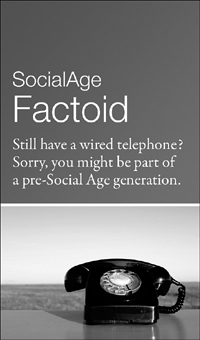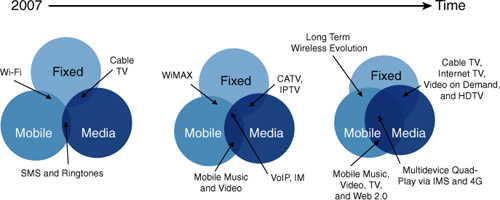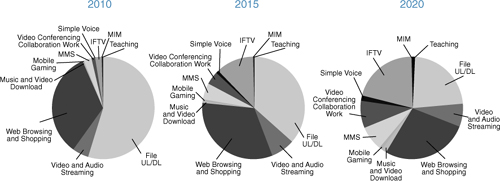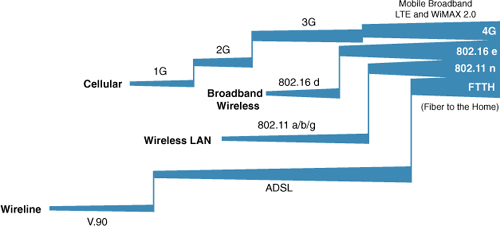Connect anywhere, any time with any device—that has long been the promise of technology for the busy professional, and the Social Age generation is perhaps the first that will see that promise fulfilled. High-performance cell phones, smart phones, and PDAs now offer the connectivity and computing power needed for ubiquitous data access.
In this chapter, we explore the way mobile devices have changed user expectations and the ways mobility is becoming a critical enterprise service. We touch briefly on trends in mobile computing devices, including the evolving role of 4G (fourth generation) networks and the way Social Age interaction will take advantage of the extraordinary power of these mobile networks. In the second half of the chapter, we discuss the role of 3D virtual worlds in the Social Age and the potential impact these interactive worlds will have on your business.
Social applications such as MySpace are nice to have, but are they appropriate—or relevant—for the mobile enterprise user? Is it reasonable to expect social tools to join e-mail, calendar, and address books as part of the mobile computing core for business productivity and efficiency? The answer to both these questions increasingly seems to be “Yes.”
Business people everywhere are beginning to appreciate the tremendous power of having more than just name, address, and phone number at their fingertips as they’re about to walk into an important customer meeting. You can always use more information about a customer as a way to accelerate or enhance the relationship. But with today’s mobile applications, you can also quickly access product information, or even connect with a product expert who can provide the answers you need at the critical moment in the meeting.

Around the world, to support this trend, mobile devices are becoming increasingly “social.” In the United States, BlackBerry and Windows Mobile-based devices remain the most popular smart phone choices, whereas in Europe, Symbian platforms on Nokia and Sony Ericsson devices dominate. Applications such as MySpace for BlackBerry are a natural step in the overall evolution of the Blackberry as an enterprise-centric platform, joining the foundational “push e-mail” technology responsible for the Blackberry’s initial wide acceptance.
Our connected culture is evolving rapidly. Children and young adults see a world in which mobility is not the exception, but the rule. For them, the connected office is much less important than making a social connection with a friend on their smart phone. Several factors are in play here to make all this happen, including many applications that were born on the Internet but which are quickly maturing in the increasingly mobile world. Three of these applications are MySpace, LinkedIn, and Facebook.
MySpace users have the ability to contribute profile information, create blogs, maintain groups, upload photos, embed music and video, and become part of a network of friends or associates. In June 2006, MySpace was the most successful social networking site in the United States,[1] and as of April 2008, it was surpassed only by Facebook in terms of total unique monthly visitors worldwide.[2]
In November 2008, MySpace went mobile. For the first time, MySpace for BlackBerry Smart Phones extended the MySpace desktop user experience to the mobile phone. Within the first month of release, MySpace for Blackberry users downloaded more than 1 million copies of the application. More than 15 million messages were sent, and user “mood” and “status” were updated over 2 million times.
With the introduction of the Blackberry application, MySpace appears poised to capitalize on the emerging workforce already familiar with MySpace. This demographic was introduced to MySpace in high school, college, and in their early working life. Although not currently focused on the corporate landscape, MySpace remains a popular friend-oriented contact gathering and management tool.
As we touched on in Chapter 7, “Social Media and Culture,” although LinkedIn is more “Contact Networking” than strict “Social Networking,” it is poised to address the critical need of merging these two worlds and playing an important role in the way Customer Relationship Management (CRM) is done in the Social Age. LinkedIn Mobile (m.linkedin.com) gives users the ability to create a profile that includes current and past employment, education, primary connections to others, links to Web sites, and a public profile that can easily be added to e-mail closings or web pages.
Recent enhancements to LinkedIn have included the ability to subscribe to a more extensive tool set for finding people and resources more effectively and a LinkedIn Answers feature, similar in nature to Google or Yahoo services. LinkedIn Answers differentiates itself from other services in its capability to provide answers that contain information related to specific business needs or industry sectors. For the mobile, socially networked professional, these tools can offer a powerful tactical advantage during customer interactions.
Also born on the Internet, Facebook has created mobile applications for several device platforms. The BlackBerry application is in many ways similar to the MySpace mobile application. Although aligned with the “friend” metaphor, the Facebook application lends itself more closely to corporate use than MySpace. At the same time, an alphabetized list with pictures and names provides Facebook with a look and feel more closely resembling the contact-oriented LinkedIn interface.
A number of years ago, IBM anticipated the increased dependence on mobile computing and began building a variety of mobile-ready applications, including the IBM Bluepages employee directory. Bluepages is a mission-critical application, so successful extension to mobile devices was considered vital to the organization.
Given the diversity and the global nature of the IBM employee population, using a web application approach (rather than a dedicated mobile application) proved much more flexible. The web-application approach readily accommodated a vast array of smart phones that were already in common use within the global corporate community, including Samsung, Windows Mobile, Nokia, Sony Ericsson, Blackberry, and iPhones.

In parallel with the application development process, key decisions were made about the rollout of the application. User documentation, videos, and other supporting communications were developed to support the deployment. These forms of communication proved invaluable when seeking validation and stakeholder support for the overall effort.
IBM estimates that by the year 2015, the world will have more than five billion people connected to the Internet, most of them by wireless connection. The billion users we see coming along over the next few years will be in emerging markets, where broadband growth will be driven by demand for access to the Internet for the first time. These emerging markets will deploy ubiquitous mobile broadband across vast regions, providing many of the same wireless services now enjoyed in major metropolitan areas around the world today.
As we discussed in Chapter 1, “Dawn of the Social Age,” the speed of the communications revolution has amazed all but the most prescient experts. You might remember the excitement of doubling the speed of your Internet connection...to 56K...via dial-up modem! Now multimegabyte download speeds are common for even the least expensive wired connections.
Broadband connectivity in the home and office quickly led to an expectation that service at these speeds would be available everywhere, any time, on every device, wired or wireless. As with every step in the evolution of communications, the challenge for mobile developers has been to push as much information as possible through the infrastructure, as quickly as possible, and deliver it to the end user at a competitive cost. Mobile users increasingly demand the computing power—and resulting productivity gains—on their mobile computer that they have long enjoyed on their wired computers. The concept of the triple play (data-voice-video) and quadruple play (data-voice-video-broadcast) networks becomes more applicable to consumer and business users as these networks become more capable of automatically recognizing the device used. An application can then deliver the desired content and information in an appropriate format.
Functions, features, and the ubiquitous nature of today’s social networking applications will continue to evolve. With the integration of GPS, cell tower localizations, and Wi-Fi positioning systems, a new opportunity is emerging for geosocial networking. These same services have empowered a number of applications that enable users to find out “who’s here,” or find and connect with a particular product or service that is available locally.
Although most social networking sites promote and enable virtual relationships, emerging location-sensitive, geosocial networking sites will likely promote more in-person collaborations. Brightkite.com is a good example of a location-based social networking tool that enables you to remain in touch with your friends through an iPhone application. Brightkite automatically keeps track of your friends’ locations and suggests places of interest to get together, such as a local restaurant or club. These same applications might even serve to extend opportunities back to brick-and-mortar retail outlets and services opportunities. If you’re driving by your favorite home improvement store, for example, you might find an advertisement from the store on your GPS-enabled handheld, notifying you of a sale that day. By agreeing to have this service on your handheld, you save money. But at the same time, the store has immediate feedback about the effectiveness of its push-advertising over the mobile medium.
All these capabilities and opportunities will continue to evolve as 4G wireless matures and becomes the standard for mobile—and fixed—communication.
The WiMAX Forum is an industry-led, not-for-profit organization with more than 500 member companies formed to certify and promote the compatibility and interoperability of broadband wireless products. There are currently more than 300 WiMAX deployments and trials underway by operators in 118 countries worldwide.[3]
In addition to higher transmission speeds, WiMAX solutions will make use of advanced multi-antenna signal processing techniques, allowing for true mobile computing for the first time. 4G wireless holds the promise to bring together under a single umbrella a variety of previously separate telecommunications media, as illustrated in Figure 12.1.
Mobile WiMAX[5] (802.16e) is focused on the concept of personal mobile broadband and is complementary to WLAN and 3G cellular. Mobile WiMAX was developed as an open IP network architecture technology platform that outperforms 3G and has less demanding intellectual-property licensing terms. With a WiMAX account the subscriber can use the same broadband account for Internet access at home or in the office and mobile roaming.
Beyond just voice and short messaging services (SMS), consumers and business users expect increasingly easy access to bandwidth intensive value-added services and applications. These services include
• Enhanced communications such as VoIP (Voice over IP)
• E-mail and Instant Message service that is secure and auditable
• Games
• Interactive TV and radio
• Video on Demand (VOD)
• Web browsing
• News and real-time financial information
• Podcasting
• Mobile office and mobile workforce solutions such as VPN, Intranet access, corporate e-mail, scheduling and rich multimedia Unified Communications (UC) applications
• Social computing and GPS-powered, location-based services
A worldwide boom in Wireless Personal Broadband (WPB) is now under way, following the successful launch of 3G (3rd Generation) mobile broadband services such as High-speed Downlink Packet Access (HSDPA) and Evolution-data Optimized (EVDO), and by 4G technologies such as Mobile WiMAX.
Mobile voice traffic is especially noteworthy in developing markets with large populations such as China, India, and Africa. Parts of the world where people have never used a fixed phone or computer before are also experiencing explosive growth in mobile telecommunications. On a global basis, however, mobile data, rather than mobile voice, is in ever-greater demand. According to Informa Telecoms & Media, mobile data traffic will overtake mobile voice traffic globally in 2011 and will account for an amazing two-thirds of total mobile network traffic by 2012.[6] Future mobile broadband converged devices will include WiMAX, a key part of the 4G wireless standards. Mobile WiMAX operators will provide hot spot coverage across an entire city—and not just for stationary users. Fully mobile users, even in a moving vehicle, will access all the same content and applications.
Convergence of WPB will occur as fixed, mobile, and media join to reduce costs and enable new integrated services (see Figure 12.2). Industry consolidation is likely to continue, with fixed and mobile telecom companies merging with the media industry (broadcasting) to deliver new services, applications, and content across IP-based mobile platforms. This consolidated approach will be more appealing for the end user and be less expensive and easier to use.
Figure 12.2. Convergence of fixed wire connectivity, wireless solutions, mobile solutions, and new media will enable new integrated services.

Triple- and quadruple-play networks become more applicable to consumer and business users as these networks become better able to recognize which device is currently used. The desired content and information can then be formatted and delivered most efficiently. Mobile broadband devices today can already sense whether Cellular or Wi-Fi access offers a better means for connectivity to the network and respond accordingly. Future converged mobile devices will include WiMAX, which will support multimedia applications and web-based content that was previously available only on a fixed broadband connection. These applications can now include nomadic office services, access to personalized entertainment, and network-based storage applications. As these applications become increasingly common, the distribution of traffic will continue to evolve, as shown in Figure 12.3.
Figure 12.3. Predicted traffic distribution by Wireless Personal Broadband (WPB) Applications from 2010 to 2020.[7]

Earlier we looked at the migration of applications such as LinkedIn, Facebook, and MySpace from the desktop context to a fully mobile context. Bandwidth restrictions have long limited which fixed applications can effectively operate on mobile devices. Those restrictions are being rapidly addressed, and with the growing acceptance of 4G, a host of other Social Age applications are now lined up to make the jump to your handheld device.
Perhaps among the most bandwidth-hungry applications in the desktop world are graphics-intensive 3D game platforms such as World of Warcraft and virtual worlds like Second Life. Graphics, however, are only half of the equation. In addition to a sharp graphical display, these applications require high-speed connectivity to ensure a realistic, real-time participant experience. Technologies such as 4G—and beyond—will increasingly make even these applications available to mobile users.
As the virtual world Second Life (www.secondlife.com) has demonstrated, immersive, interactive 3D environments (three-dimensional virtual worlds) motivate, stimulate, and inspire users in ways never before seen. The potential impacts and opportunities of 3D virtual world environments are just beginning to be understood. But we will focus primarily on the implications of virtual worlds on social networking and its impact on the enterprise.
Creative modern inventors have always built electronic devices to facilitate game and play. The earliest computer games pitted human against computer, just as they do today. A.S. Douglas programmed a tic-tac-toe computer game in 1952 for his Ph.D. dissertation about human-computer interaction.[8] But leveraging computers, networks, and displays does not necessarily result in isolated interaction with machines. Computers have also long been used to create a competitive environment in which one person can engage with another in a gaming interface. In 1958, Brookhaven National Laboratory’s William Higinbotham got things rolling when he programmed an oscilloscope for two users to play virtual tennis. These early beginnings had already identified the major features of games and virtual worlds: the graphical display, the real time simulation of physical laws, and the interaction of multiple users.
Fast-forward to 2009, where by age 21, the average person will have spent 10,000 hours playing video games.[9] Many of these games are still human against computer, but a host of other games now facilitate person-to-person competition, and increasingly, person-to-many-person competitions across the Internet. The “Massively Multi-player Online Role-Playing Game” (MMORPG) World of Warcraft has millions of players worldwide.
A number of years ago we also began to see the next stage in the evolution of online gaming and social interaction: 3D virtual worlds. The authors of “3D Social Virtual Worlds—Research Issues and Challenges” contend that Virtual Worlds “are beginning to shape the knowledge-based and globalized societies and economies of tomorrow.”[10]
Virtual worlds create three-dimensional space as a graphical representation on the computer display and allow navigation through that space. The space is filled with objects that have spatial relation to each other. Virtual worlds can often be shaped according to taste, with custom landscapes, plants and trees, building structures, furniture, machines, and a virtually unlimited range of objects. These objects can be completely imaginary or they can have a real-world counterpart.
In a virtual world, “simulation” introduces a sense of dynamic time and action. Simulation often also re-creates basic laws of nature. Virtual world gravity causes objects to fall, for example, as we expect them to do on earth; or the progression of morning dawn, bright noontime sun, and an orange-red sunset glow in the virtual world mirrors our own real-world quotidian cycle. But simulation can also be used to create machines; for example, in the form of vehicles to provide transportation.
Just as simulation inserts the concept of time into a virtual world, simulation also introduces the characteristic of “state” and state persistence. As we would expect in the real world, governed as it is by the laws of physics, the wall of a house is expected to remain standing until someone destroys the house. An object that falls to the ground to a stable position is expected to remain there unless it receives another impulse. A parked car should stay parked until someone moves it. For that purpose, virtual worlds update and preserve the state of all objects in a logical, aggregated data set known as “the world state.”
But all that’s just context. In the Social Age, our focus is on people, how they interact in virtual worlds, and the ways they behave. TV shows and movies share one characteristic—our interaction with them is passive and unidirectional. Virtual worlds are, by contrast, an interactive environment. Because of this 3D, interactive environment, we can know and be known on a much deeper level than we can be with just the text-based medium of the community-oriented wiki environment.
In the virtual world, you’re represented by a graphical image known as an avatar.[12] The avatar is guided by keyboard, mouse, or other input devices by the real-world participant. The avatar allows the participant to observe and interact with the virtual world and make his or her presence known. For example, as a participant enters a scene in the virtual world, a door opens and the avatar walks through. Other participants know that someone has come into the world, and they can watch as the avatar engages in activities, or as the avatar approaches other avatars for social interaction.
Noticing another participant’s avatar is the first step to interaction. As in the real world, you can start a conversation with someone you’ve never met before as you walk by him. Interacting and conversing in a virtual world is facilitated through text chat and voice conversation. Avatar gestures can be used to offer nonverbal communication. Simple animations of the body to clap the hands, for example, show support and excitement. Movement of the avatar away from a conversation can show disinterest in a nonverbal way.
Many users invest considerable time and effort to customize and design their avatar. Just as in the real world, the outward appearance and the first impression is the basis for judgment in the “blink of an eye.”[13] Some virtual worlds allow a wide range of avatar representations and detailed modifications. Human forms in all sizes, shape variations, and colorations can be combined with all kinds of hair styles, clothing, and accessories. Many users choose nonhuman avatars that take the form of fantasy characters, comic book heroes, furries,[14] or more abstract forms such as machines and vehicles.
Avatars allow for freedom of expression and provide the opportunity to break out of the limitations of the real world. A BBC documentary[15] tracked the lives of two couples who met and fell in love as avatars on Second Life. When they met in the real world, one of the couples (who looked not at all like their avatars), apparently were still sufficiently attracted to one another to marry (in real life, but using a Second Life virtual ceremony) and have a child (yes, a real one) together. A study in Second Life concluded that, “on average, people report making their avatars similar to themselves, but somewhat more attractive.”[16] For business settings, however, it is usually preferable for an avatar to look at least similar to his or her real-life counterpart and maintain that appearance over time as a way to establish and foster trust relationships by visual recognition.
IBM recently held a global internal kickoff meeting in a private virtual world, with participants joining from locations around the world. A select group of employees sat on a virtual stage and answered questions from a senior vice president about their current projects, in front of the audience of avatar participants. Avatars intentionally looked similar to the real-world participants so that employees in other locations, countries, and continents could get to know each other without the usual travel, hotel bills, and conference room rentals.
One participant commented on the realism of the avatars: “I have [personally] met [the senior vice president], and [his] avatar really looked like him. I haven’t met the other panelists, but I think I would recognize them now if I saw them.” Although most of the avatar clothing reflected the daily appearance of the participants at work, the salwar kameez of the participants from India and the traditional dress from Japan allowed for expression of the rich cultural backgrounds.
As previously mentioned, the virtual world state of objects persists until the objects are acted on and state changes propagate to all observers in real time. That means that all virtual world participants see an avatar waving his hand at the same time.
Avatars make it much easier to have a shared experience in the real world, even something as simple as watching the same TV show. One study found that people liked to know—in real time—which TV shows their social group was watching.[17] The benefits of learning in a group setting have shown to include motivation through collaboration, innovation, and shared purpose.[18] In a virtual world, shared experiences are possible in countless situations. Even passive presence at a speech in a virtual world can create the sense of “having been there together.”[19]
The shared experience is taken even further when the real-time shared state is combined with the ability of users to create new objects and content in the 3D world. A user can create new objects by copying and modifying existing objects or by creating completely new geometrical objects. Several avatars can build a house; one can change the color of the wall while another is putting on the roof and a third is moving in the furniture. Because all these activities are performed—and observed by participants—in real time, they can be coordinated and discussed through voice conversation or text chat.
As we previously said, for social interaction to take place in a virtual world, the following characteristics are required: 1) represent the environment in three dimensions, 2) simulate the real world and update the persistent state of the objects; and, 3) represent the participants through avatars, and allow them to interact and communicate in real time.
In his analysis of the history of social interaction, Ray Oldenburg described the “Third Places”[20] where people congregate. In many cases, Oldenburg found, people don’t go to German beer gardens with a specific goal or with the intention to consume entertainment. Although the beer is certainly a good excuse, it appears there is a more generalized appeal to this setting. Meeting and spending time with friends, enjoying the outdoor setting, doing some people watching, and conversing with others is just as important. Such unplanned interactions sometimes lead to great inventions or are the start of business dealings. Virtual worlds have the potential to provide the same kind of creativity and business success.
One participant at a recent corporate kickoff commented on the ability of the virtual world to create a sense of sharing, not only of the space and content and information, but also a sense of sharing the same experience, moment, and presence. “There’s something about that sense of co-presence,” she said. “There was some sense of them being together somehow, that ability to bring everyone together from India, Tokyo, and China. Rather than having four distinct screens, where everyone is separated with different phone hookups, this felt more cohesive.”
People have flooded into virtual worlds, created avatars, acquired islands, built houses, and designed landscapes. Some of these worlds have hundreds of thousands of users logged on at the same time and individuals often spend several hours a day “in world.” Interactions between users are started with little effort, offering a unique security that allows adults to approach each other as children do at a playground—with boundless curiosity, innocent trust, and an ever-present sense of wonder. Virtual worlds bridge countries, cultures, social status, and many other barriers that serve to limit unfettered interaction in the real word. A person’s profile, interest, and favorite places are easily viewable in the virtual world, making it easy to find like-minded people.
But what value is there in a virtual world for business and professional users? Three use cases in marketing, product lifecycle management, and learning provide valuable evidence of the effectiveness of virtual worlds in a business setting.
Marketing professionals are always on the lookout for the next hype, the next subculture, the next medium to carry their message. Brands in the real world have a presence in online games and virtual worlds, and surveys have shown that consumers’ attitude toward brands and companies is influenced as a result.[21]
These results should come as no surprise, considering the obvious match between the characteristics of virtual worlds and the objective of advertisers to reach the largest number of people with content personalized to their interests. At the same time, advertisers can more easily gauge the response of the audience in a virtual world to a particular advertisement or promotion. Companies seek to present their products and brands in the best possible light, with the highest resolution, and with the most realistic rendering and natural colors. Although virtual worlds still lag glossy print media and high-definition movies and television in these areas, they compensate by breaking free of the limitations of traditional, passive media.
A car shopper can experience the product in a three-dimensional perspective, for example, by looking at a new Mercedes Benz[22] in all imaginable camera angles. Through interactive simulation the car buyer—in avatar form, of course—can “drive” the car on a race track. After the car shopper successfully finishes the course, his avatar can keep the race suit as a souvenir. As the avatar moves around the virtual world, he is now known for his driving prowess and for his interest in a particular car brand. At the same time, the advertiser gains a dynamic presence in the virtual world through the avatar, much like the “Morris columns” seen throughout Europe that serve as advertising platforms. For example, in Figure 12.4 you can see a virtual “Morris column” advertising this book.
Figure 12.4. Virtual worlds can be an effective advertising channel for activities and goods that exist in the physical world. This virtual world “Morris column” advertises The Social Factor.

Much higher levels of involvement are available to advertisers in a virtual world than in traditional lean-back media. In a virtual, 3D world, the consumer is compelled to engage, lean forward, and experience the product, leading to greater desirability for the brand and the product.
Additional interest in a product can happen in 3D space when social elements come into play. For a family interested in a kitchen upgrade, for example, a 3D kitchen shop enables them to combine cabinets and to experiment with design variations. By working with a detailed virtual model of the actual kitchen space, they ensure that the selected parts actually fit. The family can “walk around” and get various perspectives, and even invite extended family and friends to join them to offer opinions and suggestions before they place the order.
As three-dimensional objects, furniture, cars, fashion and clothing, toys, and consumer products are ideal for representation in a virtual world. Computer-aided design and manufacturing (CAD/CAM) has been in use for several decades, and is one of the earliest uses of IT in small and medium businesses.
Until recently, however, CAD/CAM applications and programs were optimized for a single user interacting with the tool. The design was shared by forwarding the data set after completion of each design phase. This approach ignored the creative and problem-solving process on which much of product design is based. In traditional CAD, a draft is sometimes printed out on paper and discussed by a team of people that marks up the paper with possible changes. Or the team gathers around a single workstation, possibly crowding together to have a good view of the monitor. Participants point out features or elements they want to change or discuss and sometimes even swap back and forth the input controls to update the draft.
This traditional approach is slowly giving way to a new perspective on product life cycle based on socially networked virtual worlds and the four primary elements of product life cycle: development, production, distribution, and after-sales management.
Product development is affected by current trends toward crowd sourcing, where extensive feedback is solicited and highly valued. Geographically dispersed populations participate in early functional evaluation, focus groups and clinics, and R&D cooperation between manufacturers and suppliers. Consumers are motivated to participate in product design for a variety of reasons. Perhaps they have a personal interest in a product, or they enjoy interacting with like-minded people to create an exciting new product. Self-esteem, including possible feedback through commendation and respect, motivates others, whereas some participants might just enjoy taking on and succeeding at a challenge.
Even if consumers are not included in the initial design, the early feedback they provide in functional evaluations and product clinics is invaluable. The earlier such a dialog can be established for customer feedback and insights, the more closely risk can be managed. Facilitating feedback with a representative and large group on early prototypes is either costly, for example in the case of a coffee maker, or outright impractical when the product is a car. With virtual pilots, a company can easily get feedback on models presented in a virtual space.[23] In 2008, IBM created a pilot for a 3D game called PowerUp to engage high school students with this new collaboration medium (Figure 12.5). The students were introduced to several engineering tools with which they designed solutions for energy problems encountered during the game. The result of the students playing the game was an overwhelming interest in the fields of engineering and science. Students and parents alike loved PowerUp, demonstrating the power of this 3D technology not only to effectively market the study of engineering and science, but also to bridge the generation gap!
Figure 12.5. Virtual world created for IBM’s PowerUp game to engage high school students in the fields of engineering and science.

Many companies use virtual environments to facilitate product configuration and gain an edge into a more personalized marketing approach. The automotive and furniture industries have a particular advantage in this area, but clothing and fashion also benefit. Web pages now offer choices of components, designs, shapes, and colors and then present the result in 3D with navigation for rotating and zooming.
Finally, in after-sales management the use of virtual worlds for interaction with the customer is somewhat limited. Service and maintenance, however, often require extensive training. This is the perfect context for the use of collaborative 3D spaces. To train a mechanic on a new car model, for example, traditionally requires a substantial commitment in time and money. But exceptional service has a direct connection with customer satisfaction, so compromise in this area can be detrimental to the business.
In a virtual world, a new car model can be disassembled, parts replaced, and repairs easily demonstrated. These processes can be practiced in the virtual world until the learner feels comfortable with the process, and the trainer’s avatar can offer tips and suggestions to make the job go more quickly. Also, training can take place before the first product is even shipped, without the high capital expense for “training models.” The risk of damaging real products during trial-and-error training is also avoided. The trainer’s avatar can demonstrate procedures, and there is no practical limit to the number of participants. The interactive nature of a virtual world allows easy interaction between trainer and learners. Virtual products can be manipulated faster than real-world products.
Failure conditions or problems that would be difficult or impossible to re-create in the real world can also easily be simulated in the virtual world. Such environments can also be used for problem determination or for getting expert help. When a mechanic encounters an issue, for example, he can reach out to a product expert from the manufacturer who joins him in a virtual world around the virtual product to point out methods and options.
The basic technology of virtual worlds has been around for some decades. Today’s large scale implementations of social virtual spaces, however, still lag the immersive experience that the leading PC and console games offer through superior graphics, resolution, user interface, and sound. Challenges remain for virtual space engineers to solve, such as the real-time distribution of user-created content and the large-scale, shared space that differentiate virtual worlds from online games.
Virtual space and worlds will become increasingly valuable to business users when relevant content (business procedures, documents) and interaction is possible. Existing applications, data, and documents must be connected to virtual worlds, and the flow between the 2D Web, mobile devices, and virtual worlds must become seamless.
As we explored briefly in Chapter 10, “Social Innovation,” interesting advances are being made in the area of human-computer interfaces, including devices such as Emotiv Inc.’s EPOC headset. A couple of generations of kids have been trained to use the A, W, S, and D keys on their keyboard to move a character on the screen forward, backward, and sideways, but such a primitive approach does not make good use of our dexterity and tactile capabilities.
Haptic[24] technology, on the other hand, which “interfaces to the user via the sense of touch by applying forces, vibrations, or motions to the user,” is an exciting field of ongoing research, and prototypes offer a promising glimpse into the future. Similarly, the true impact of a Cave Automatic Virtual Environment (CAVE) where projectors display a virtual world on three to six walls of a room must be experienced in person to be appreciated. Such an installation is remarkably realistic and immersive.
One tester commented about his experience in the CAVE: “When I put on the glasses and looked around the room,” he said, “I involuntarily ducked down to avoid hitting my head on the large jet engine that was suspended in the virtual space.” Wired gloves that are worn in a CAVE capture arm, hand, and finger movements and offer a more natural interaction with the objects in the space. “There was no need for training, education, or even a word of explanation,” the tester said. “Rotating and interacting with the jet engine happened naturally through the data glove.”
Like many technologies in an earlier day, whose long-term viability was hotly debated, but which are now ubiquitous, virtual worlds are met with a range of opinions about their future. The excitement and hype surrounding virtual worlds is real, but there are also legitimate criticisms and sometimes outright rejection based primarily on technical capabilities and limitations.
As the characteristics and use cases of virtual worlds have shown, however, the biggest motivation to participate in a virtual world is the insatiable drive people have for being with other people. We need social interaction and shared presence. We recognize that business and work are built on collaborative processes, and a 3D virtual world offers a connectedness unknown in earlier technologies. Geographically dispersed families, peer groups, and work teams all come together in a virtual world. A shrinking world gets even smaller when countries, time zones, and cultures are bridged in a virtual world. Virtual spaces that allow people to interact in real time and share an experience can become alternative places for some of our work and our life.
As we’ve previously discussed in detail, organizations realize that success depends on collaboration. 3D virtual spaces that allow people to interact in real time and to share an experience—no matter the actual geographic distance—are an ideal context for this purpose. And with the increasing speed of our mobile devices, these interactions will increasingly take place any time, anywhere, on any device.
• Mobility applications are of critical importance to businesses to ensure that employees on the road stay connected with each other and the rest of the enterprise.
• Expectations have changed to the point that connectivity is taken for granted.
• Digital convergence is bringing together traditional wire line services, wireless, and new media. This creates new ways to communicate and collaborate in a connected world.
• 3D is still in its infancy but is evolving quickly in ways that provide an increasingly immersive experience.
• 3D is a new way to collaborate with others and advertise your products and services.

